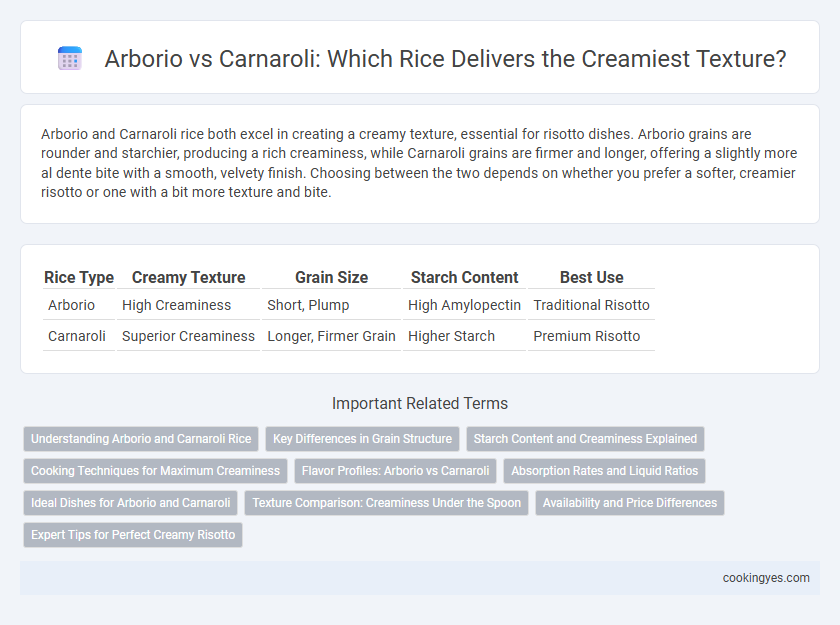Arborio and Carnaroli rice both excel in creating a creamy texture, essential for risotto dishes. Arborio grains are rounder and starchier, producing a rich creaminess, while Carnaroli grains are firmer and longer, offering a slightly more al dente bite with a smooth, velvety finish. Choosing between the two depends on whether you prefer a softer, creamier risotto or one with a bit more texture and bite.
Table of Comparison
| Rice Type | Creamy Texture | Grain Size | Starch Content | Best Use |
|---|---|---|---|---|
| Arborio | High Creaminess | Short, Plump | High Amylopectin | Traditional Risotto |
| Carnaroli | Superior Creaminess | Longer, Firmer Grain | Higher Starch | Premium Risotto |
Understanding Arborio and Carnaroli Rice
Arborio and Carnaroli rice are both Italian short-grain varieties prized for their creamy texture in risotto dishes. Arborio rice has a higher starch content that releases during cooking, producing a rich, creamy consistency, while Carnaroli rice is often preferred by chefs for its firmer texture and better resistance to overcooking. Understanding the subtle differences in starch release and grain structure helps determine the best choice for achieving optimal creaminess and bite in risotto recipes.
Key Differences in Grain Structure
Arborio rice has a shorter, rounder grain with a higher starch content that releases quickly during cooking, creating a creamy texture ideal for risotto. Carnaroli grains are longer and firmer, retaining their shape better while developing a more delicate creaminess due to a balanced starch release. These key differences in grain structure make Arborio more forgiving for beginners while Carnaroli is preferred by chefs seeking a perfect al dente bite with rich creaminess.
Starch Content and Creaminess Explained
Arborio rice contains a high amount of amylopectin starch, which breaks down during cooking to create a rich, creamy texture essential for risotto. Carnaroli rice has an even higher starch content and firmer grain, allowing it to release starch slowly while maintaining a slightly al dente bite. This balance of starch release and texture makes Carnaroli preferred for achieving optimal creaminess and structure in Italian rice dishes.
Cooking Techniques for Maximum Creaminess
Arborio and Carnaroli rice differ in starch composition, impacting creaminess in risotto; Carnaroli has a higher amylose content, providing superior firmness and creaminess when cooked properly. To achieve maximum creaminess, use a gentle simmer and gradually add warm broth to allow the rice to release its starch slowly, creating a luscious texture. Constant stirring is essential to agitate the grains, enhancing starch release and ensuring a rich, creamy consistency distinctive to traditional Italian risotto.
Flavor Profiles: Arborio vs Carnaroli
Arborio rice offers a creamy texture with a slightly nutty and buttery flavor, making it ideal for traditional risottos. Carnaroli rice provides a firmer, al dente bite paired with a delicate, subtle taste that enhances the richness of creamy dishes. Both varieties excel in absorbing flavors, but Carnaroli maintains its structure better during slow cooking, delivering a more refined mouthfeel and flavor balance.
Absorption Rates and Liquid Ratios
Arborio rice has an absorption rate of approximately 2.5 times its volume, requiring a liquid ratio of about 1:3 for optimal creamy risotto texture. Carnaroli rice absorbs liquid slightly less rapidly but retains more starch, supporting a richer, creamier consistency with a liquid ratio close to 1:3.2, making it preferred for slow cooking and maintaining firmness in risotto dishes.
Ideal Dishes for Arborio and Carnaroli
Arborio rice, known for its creamy texture and ability to absorb flavors, is ideal for classic risottos and creamy rice puddings, enhancing dishes like mushroom risotto and seafood risotto. Carnaroli rice, often called the "king of risotto rice," retains a firmer texture and offers exceptional starch release, making it perfect for traditional Italian risottos such as saffron risotto and risotto alla Milanese. Both types excel in Italian cuisine but differ slightly in texture and creaminess, allowing chefs to choose based on desired dish consistency.
Texture Comparison: Creaminess Under the Spoon
Arborio rice delivers a rich, creamy texture due to its high starch content, which breaks down easily during cooking to create a velvety consistency. Carnaroli rice maintains a firmer bite while still producing a luxuriously creamy sauce, prized for its balance of creaminess and structure. The choice between Arborio and Carnaroli depends on whether a softer creaminess or a more resilient, yet creamy texture is preferred in risotto preparation.
Availability and Price Differences
Arborio rice is widely available and generally more affordable, making it a popular choice for creamy risottos. Carnaroli rice, often referred to as the "caviar of rice," has a higher price point due to its limited availability and superior starch content that enhances creaminess. While both varieties deliver excellent texture, Carnaroli's rarity and cost may influence purchasing decisions for budget-conscious cooks.
Expert Tips for Perfect Creamy Risotto
Carnaroli rice provides a higher starch content and superior grain firmness, making it ideal for achieving a consistently creamy risotto texture. Expert chefs recommend Carnaroli for its ability to absorb liquids slowly without becoming mushy, preserving the risotto's al dente core. Arborio rice can also produce creaminess but tends to release starch more rapidly, which may result in a softer, less structured dish.
Arborio vs Carnaroli for creamy texture Infographic

 cookingyes.com
cookingyes.com